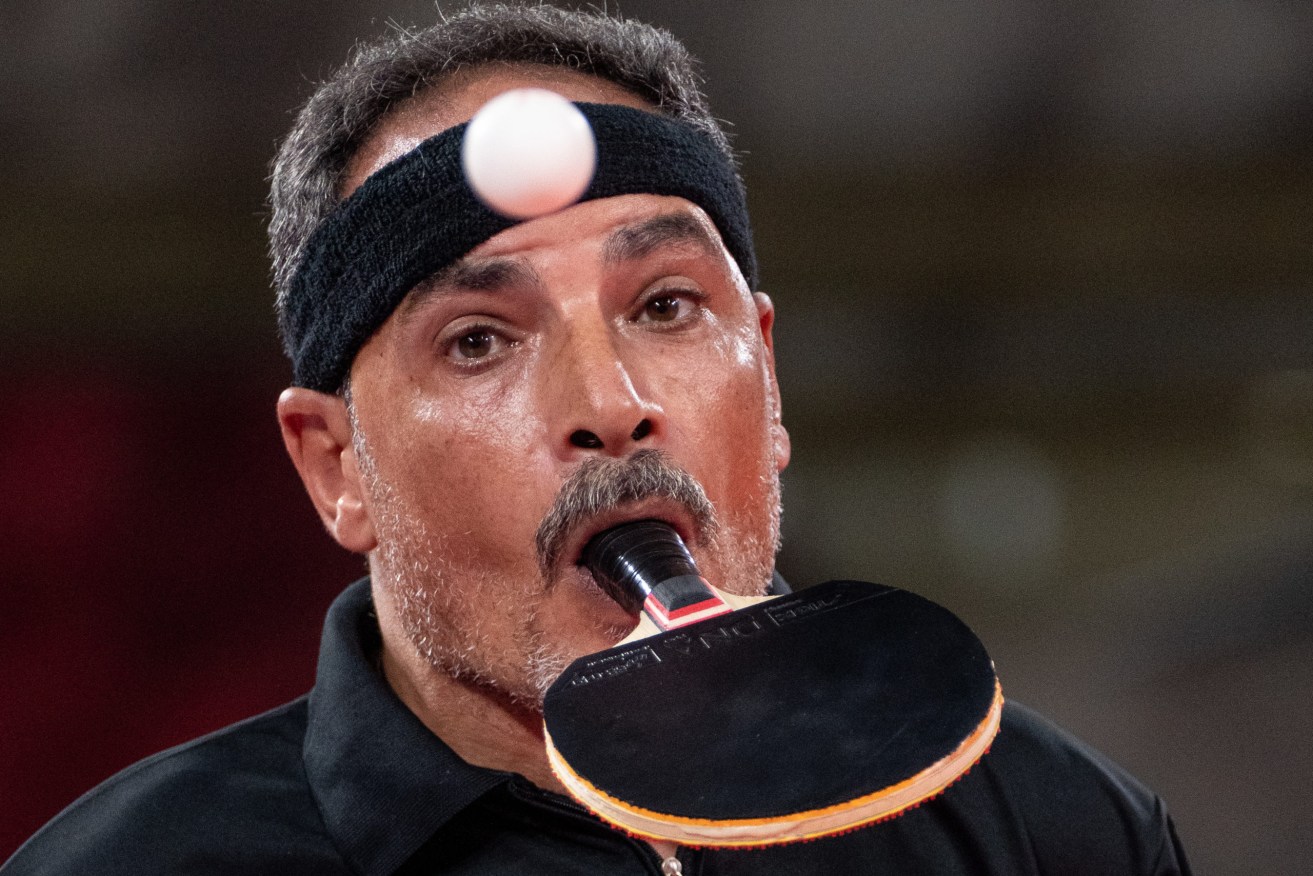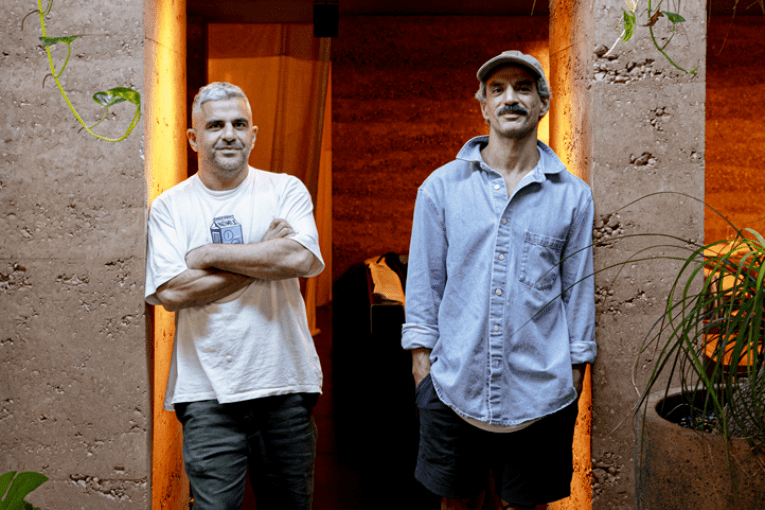Faster, higher, stronger? How about ‘bloody remarkable’
Want to see something truly life-changing? Forget the Olympics for a moment and check out the world’s real jaw-dropping athletes, writes Michael Blucher


Egyptian table tennis player Ibrahim Elhusseiny Hamadtou, who holds the bat with his mouth and serves with his toes because he has no arms, is typical of the inspiring athletes on show during the Tokyo Paralympic Games, (AAP Image/OIS/ Bob Martin)
In another place, at another time, I might have had to tell myself to be patient, as I stood in the queue, waiting to self serve dinner from the enticing array of pre-cooked food in front of me.
But not now. Not here. What was going on all around me was pure art. As beguiling as anything I’d witnessed.
To my immediate left, a young bloke in a Brazilian tracksuit hoisted his right leg high, unbelievably high, and with one swift motion, picked up a heaped dinner plate between his toes. Without displacing a single green pea, he gently lowered the feast onto the tray, resting on the stainless steel railing in front of him.
Logical question … why he didn’t use his arms?
Simple answer … he didn’t have any. Not at least with hands attached. From the look of his tracksuit top, he did seem to have some sort of residual limb, but of indeterminate length. And only one. Not much good for plating up roast pork, pasta, potatoes and peas.
Two perfectly apportioned and phenomenally dexterous feet however…
Welcome inside the main food hall of the 2000 Paralympic Games in Sydney, where nothing happened quickly. And I mean nothing.
To fully appreciate the moment, you need to picture 5000 athletes – lots of them in wheelchairs, others without arms or hands or legs, or a combination of all three, quite a few visually impaired – lining up together to get their evening meal from one of dozens of international food stalls, clustered together in the hub of the Paralympic village.
For some, there was a secondary challenge of getting their meal to the table, followed by a further task – perfunctory for most – of transferring the food into their mouth with whatever implement they could hold, in whatever limb or digit was fully functional and sufficiently flexible.
Talk about dexterity – the display of skill was mind-blowing. And this was well before any Para athlete had set foot, or more accurately wheeled themselves onto the track, or clamoured up onto the starting blocks at the pool.
Up close and personal, the Paralympics – if not the most mesmerising show on earth – it had to be close.
Like many, prior to 2000, I didn’t quite know how to categorise “elite sport with disability”. At one level, I found it inspirational, at another, uncomfortably complex, even a little contrived.
In the context of competition. how could one disability – the loss of an arm for instance, be equitably assessed against a rival who’s leg had been amputated below the knee?
Pool, track, court, quads vs paras … there was no one level playing field.
However working as a volunteer in Sydney, living for 12 days in the village at Homebush with some 280 Australian Paralympic athletes, I quickly moved past the administrative minutiae of the games. Past my own preconceptions, even past my own insecurities.
I saw the festival for what it was. An opportunity for the most determined, most dedicated, most skilful, most resilient disabled athletes from 123 countries to strut their stuff on the world stage – thankfully, while an increasing number of able bodied folk looked on … most of them thinking.. “Holy crap – these people are incredible”.
Paralympic sport gets a bad rap in some circles, simply because of the unfiltered comparison with able bodied athletes, and their mind blowing benchmarks.
“What’s so special about that? – Usain Bolt runs the distance in half the time,” the cynic hastens to point out. And then the killer clause: “Go down to any Little Athletics carnival on a Thursday night and you’ll find 11 year-old kids running faster times.”
Possibly – but is that really the point?
I bring in Sean Tweedy, local bio-mechanic brainiac, who’s devoted the past 25 years of his life to the classification of Paralympic athletes, and through that, the advance and legitimacy of disability sport.
An associate professor at the School of Human Movement at Queensland University, recognised internationally as an authority in Para sport, Tweedy suggests we look it at this way.
“Of all the people in the world with a disability – whether they were born like that, or at some point suffered a traumatic injury, only a percentage genuinely overcome their day to day challenges,” he says
“Of those, assume only a tiny percentage involve themselves in sport, as a source of personal satisfaction, or a form of rehabilitation.
“From there, understand that an even smaller percentage excel at their chosen sport. Divide by 100 again, the number who reach the pinnacle – who are selected to represent their country.
“And come Paralympics time, we’ve got 4500 of them, in the one place.”
“That’s what I’d like the general public to understand,” Tweedy says. “Anybody who is on a starting block, or lining up to compete qualifies as outstanding by any reasonable measure. So when you see them go head-to-head competing, knowing everybody has that back story brings a bit more pathos to the contest. And for mine, the guy or girl who triumphs and wins the gold medal – true champion material, worthy in every sense.”
The experts will admit the assessment and classification of Paralympic athletes is far from perfect. There’s work still to be done and he, along with his research team at the University of Queensland School of Human Movement and Nutrition Sciences are at the forefront of doing the research that can improve systems of classification.
In the meantime however, that in no way detracts from the achievements of the past, present and future Para athletes who congregate every four (in this case five) years to test themselves against their rivals – their kindred spirits – from all corners of the globe.
The current systems of classification used are the best available.
And I’m sure he’s right. He normally is – he’s one of the most considered, clearest thinking people on the planet.
In the 2021 Games, the whole Tweedy family have a heightened interest in the wheelchair rugby, because they now have a player in their midst. Conor Tweedy, the youngest of three children took up the sport during his rehabilitation from a spinal cord injury which he acquired following a schoolboy rugby scrum collapse in 2018.
From the little I know – a couple of weeks living amid the logistic hurly burly of the village, working 16 to 18 hours a day for the pure pleasure of team kit, life experience, perspective, friendship, and unlimited magnum ice creams, I’m comfortable in saying every athlete I met was in some way remarkable.
They’re fully invested – most are working, studying, training, and having families, all at the same time. They’re persistent, they’re positive, they’re dedicated, but above anything else, they’re capable of seeing the lighter side of life.
I was there when the one-legged track athlete opened up his kit bag to find three pairs of sports socks – “Wow, six pairs,” he marvelled.
Likewise, the double amputee swimmer, who while settling into his economy class seat to the Games proclaimed, “Legroom? Personally I reckon it’s over-rated.“
There’s also the nicknames: David Evans, the 1500m runner, with one normal arm and one short arm who was affectionally known as ”Clock”.
And the S5 swimmers, competing in the “washing machine” races – jump into the pool and splash around for a few minutes. They’re happy to poke fun at themselves.
As a community, we’re gradually starting to appreciate just how bloody special our Paralympians are.
Not just as athletes, but as people.
Over the next week or so, tune in. Watch closely, absorb the simple but special moments of personal triumph.
But take your time, because as we know, at the Paralympics, nothing happens quickly.












